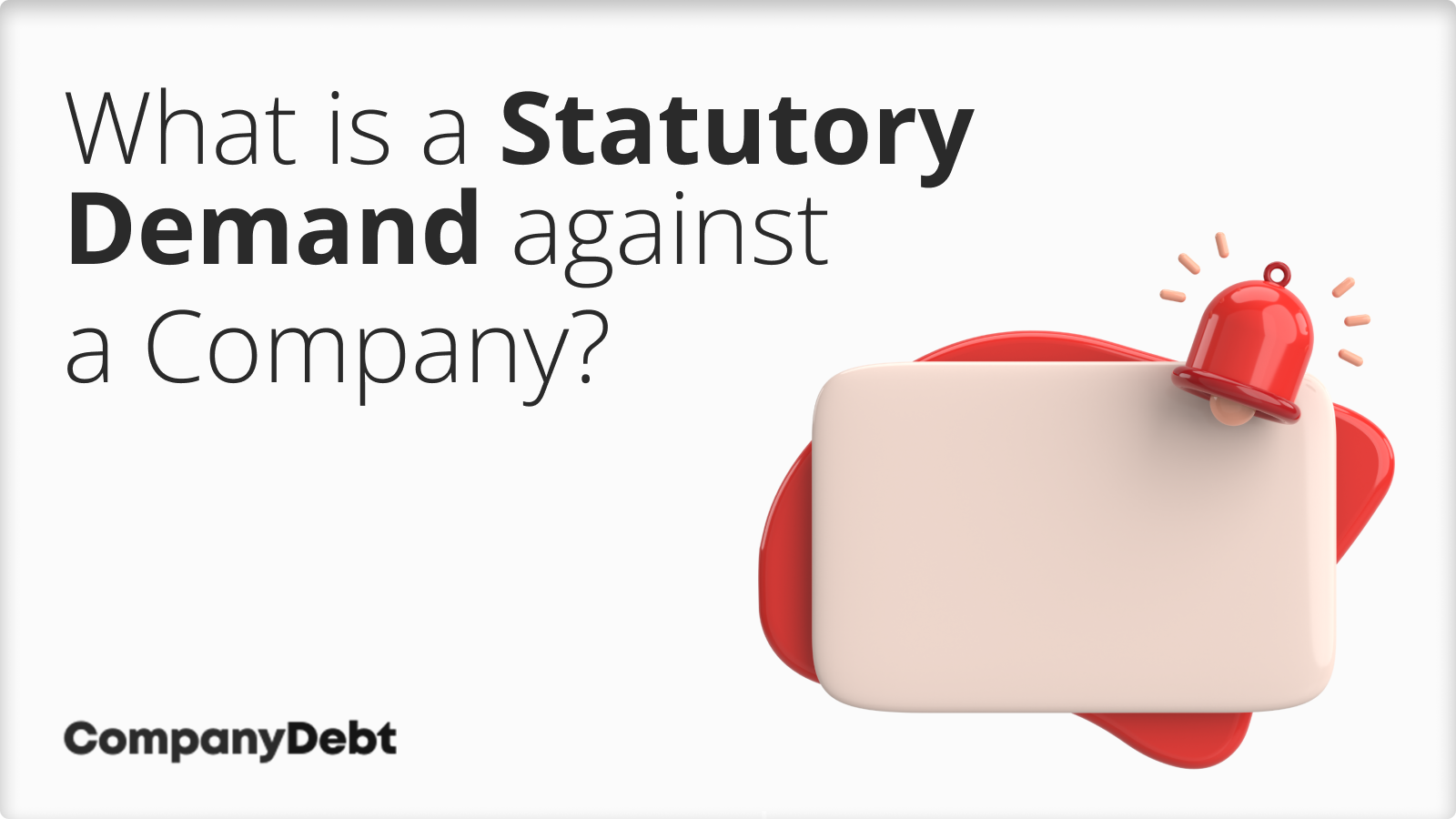
What is a Statutory Demand against a Company?
- What is a Statutory Demand?
- The Process of Serving a Statutory Demand against a Company
- Consequences of Ignoring a Statutory Demand against Your Company
- Can You Set Aside a Statutory Demand Against a Company
- Options for Companies After Receiving a Statutory Demand
- Statutory Demand against a Company: FAQs
What is a Statutory Demand?
A statutory demand against a company is a formal, legal warning from a creditor, requiring a debt of at least £750 to be settled within 21 days[1]Trusted Source – GOV.UK – Make and serve a statutory demand, or challenge one.
It’s a serious step that can lead to further legal action. If the company doesn’t address the demand, the creditor can ask a court to force the company into compulsory liquidation.
This process is defined in Section 123 of the Insolvency Act 1986[2]Trusted Source – Legislation.gov.uk – Section 123 of the Insolvency Act 1986 in the section ‘Definition of Inability to Pay Debts’ as follows:
If a creditor (by assignment or otherwise) to whom the company is indebted in a sum exceeding £750 then due has served on the company, by leaving it at the company’s registered office, a written demand (in the prescribed form) requiring the company to pay the sum so due and the company has for 3 weeks thereafter neglected to pay the sum or to secure or compound for it to the reasonable satisfaction of the creditor.
https://www.legislation.gov.uk/ukpga/1986/45/section/123
Example
Imagine your company supplied office furniture to another company, but they haven’t paid the invoice for £1,000. After multiple attempts to collect the debt, such as sending reminder letters and making phone calls, you could consider issuing a statutory demand.

The Process of Serving a Statutory Demand against a Company
For statutory demands to be valid, they must served correctly.
Serving a Statutory Demand to a company
- Download and complete the correct statutory demand form from the GOV.UK website. Ensure all details are accurate and the form is filled out properly.
- It should be given in person to the company’s director, company secretary, manager or principal officer.
- It can be left at the registered office of the company or partnership that owes money (or at the main place of business if it does not have a registered office).
- It can only be sent by post if it’s not possible to deliver it in person.
- You can use a ‘process server’ if you can’t go in person. This is a legally appointed agent your solicitor could arrange who can deliver the paperwork for you.
- Obtain proof of service whenever possible. This could be in the form of a signed acknowledgement of receipt from the recipient or an affidavit of service from a process server. Proof of service is crucial if the demand is later contested.
- Keep detailed records of all steps taken to serve the statutory demand. This includes dates, times, and methods of service, as well as any correspondence with the recipient.
Consequences of Ignoring a Statutory Demand against Your Company
Ignoring a statutory demand can have serious repercussions for your company. If you fail to address this formal notice within 21 days, you’re essentially opening the door to serious legal actions.
The most immediate consequence is that your creditor can petition the court to wind up your company. This isn’t a mere threat; it’s a very real possibility that can swiftly lead to the end of your business and Compulsory liquidation of your company.
Once a winding-up petition is issued, your company’s bank accounts will be frozen, making it nearly impossible to continue trading.
Further potential consequences of inaction include:
- Personal liability for company debts in cases of wrongful trading
- Disqualification from acting as a director for up to 15 years
- Damage to your business and personal credit rating
Even if you believe the demand is unjustified, ignoring it is never the right course of action. You must respond, whether by paying the debt, reaching an agreement with the creditor, or applying to the court to contest the demand if you have valid grounds.
Can You Set Aside a Statutory Demand Against a Company
There is no specific law for setting aside a company’s statutory demand, but you are allowed to contest the debt the same as any individual. You will need to prove it is a genuine dispute and not a delaying tactic, and you will likely need a lawyer to proceed.
In principle, if the company is successful in having the statutory demand set aside, then the creditor will have to pay the court fees.
Options for Companies After Receiving a Statutory Demand
(1) Pay the Debt in Full Or Negotiate with the Creditor
This is obviously what the statutory demand is intended to provoke, so if you can pay the debt, you should.
(2) Negotiate a Payment Plan with Creditors
By accepting your responsibility to pay the debt, while explaining your inability to settle it all at once, many creditors are open to a payment in instalments.
(3) Consider an Insolvency Proceeding such as:
- Company Voluntary Arrangement – A Company Voluntary Arrangement is a process whereby an IP helps you negotiate a long-term payment plan with creditors while protected from further creditor action by a legal ring-fence.
- Administration – Administration allows larger companies to be restructured by an Insolvency Practitioner while protected from legal action, with the goal of turning the business’s fortunes around.
- Voluntary Liquidation – If the statutory demand brings with it the realisation that your company is insolvent, you may wish to voluntarily liquidate while you still can. Once a winding up petition has been delivered, this possibility will have vanished and you will have even less control over your future.
Do You Need Free, Confidential Statutory Demand Advice?
If you have received a Statutory Demand against your company, please contact us to find out what can be done about it: 0800 074 6757; email us at info@companydebt.com; or use the Live Support at the bottom of the page.
Statutory Demand against a Company: FAQs
What’s the required format for a Statutory Demand against a company in the UK?
It must follow Form 4.1 of the Insolvency (England and Wales) Rules 2016.
Can a company request the withdrawal of a Statutory Demand in the UK?
Yes, the creditor can choose to withdraw it at any time before a winding-up petition is presented.
Can an overseas company operating in the UK be served with a Statutory Demand?
Yes, but special rules may apply depending on the company’s registration status in the UK and its home jurisdiction.
Will a Statutory Demand against a company appear on public records?
No, unlike a CCJ, a Statutory Demand itself doesn’t appear on public records. However, if it leads to a winding-up petition, that becomes public.
What should a company do after paying a Statutory Demand?
If the company pays in full, including any interest and costs, the process ends there. The creditor should confirm in writing that the demand has been satisfied.
Can a company receive multiple Statutory Demands?
Yes, if there are separate debts. However, repeatedly issuing demands for the same debt could be seen as harassment.
Can a Statutory Demand be served by email?
No, it must be personally served on a director or an authorised person at the company’s registered office, or by other methods permitted by the Insolvency Rules.
The primary sources for this article are listed below, including the relevant laws and Acts which provide their legal basis.
You can learn more about our standards for producing accurate, unbiased content in our editorial policy here.
- Trusted Source – GOV.UK – Make and serve a statutory demand, or challenge one
- Trusted Source – Legislation.gov.uk – Section 123 of the Insolvency Act 1986








